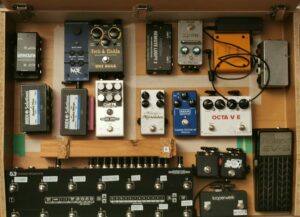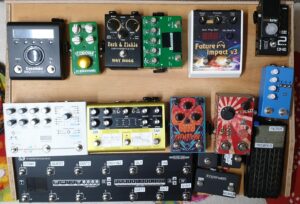DIY: Build your own Pedal Board Prototype
When I built my last pedalboard about 2,5 years ago, I already had in mind what pedalboard I would build next. I just didn't have the money at that time. Now, the time has come and I'm working on my meant-to-be-the-last-one pedalboard build. I have already watched dozens of youtube videos, done further research, and I have figured out how to make it future-proof and portable.
To find out the size of the case, I took all my pedals, plugged in some dummy connectors, drew some lines on a piece of wood, and began shifting the pedals around. At present, it looks like this:

I used a method Mason Meringella (aka the rig doctor) shows in this video:
Taking note of the approximate dimensions, I did some research to see if there was a pedalboard case on the market with the appropriate measurements which would fit my needs.
Fortunately, I found one: A Schmidt Array 650 XDM.
Unfortunately, it did not fit my budget (as it costs about 1250€). Also, some extra modifications would have been necessary in order to fit the patchbays. I decided to build a case myself with the help of a friend of mine who is an excellent carpenter. I took the dimensions and started to draw a 3D model in shapr3D, an awesome app for iOS.




Having the measurements fixed, I built a prototype out of some old wood samples I had found in my mother's basement. I put everything together and that model in itself was already quite satisfying.




With a prototype in my hands, I could now play around with the placement of all the pedals. Doing so with a real model is a game-changer! I discovered some obstacles, found solutions, discovered more problems and solved them, etc... I think I found quite a good layout and solution. In another episode from this series, I will write about the criteria and thoughts which went into this construction process.


So far so good. Next Sunday, we actually begin to build the final pedalboard case! We'll start by assembling a simple box, literally just four sides glued together. At least we will use real dovetail joints to make it stable.
After the glue will have done its magic, we will cut the box into two pieces during the following session. Doing so means that the lid will fit perfectly.
I hope you've enjoyed being part of the journey so far...... let me know if you have got any questions.
A Journey to
At concerts with the pianist and composer Arthur Possing, I usually play a version of this intro. We recorded our second album at Real World Studios in Box, England. As I was putting together a board in order to be able to play live, I thought I would share a filmed version with you. It is a little bit shaky because it was done on a rush: Take it as a pedalboard-try-out-test piece...
go to the Master Research Overview
Pedalboard Sunday - new "series" - modular pedalboard (system)
Hi you all,
Pedalboard planning & building is fun! It never stops. I truly believe that there is no such thing as the ultimate pedalboard which suits ALL of your needs. I stopped counting how many pedalboards I have assembled and rebuilt since. For many years I was on a quest for finding and building my perfect pedalboard. Almost needless to say, it would have been (or even was) gigantic and way too heavy. Hence, totally unpractical! So, three years ago I came up with the idea of a modular pedalboard (system). What if I had a "basic" board that woul provide the option of integrating rarely used effects? This concept turned out to be a real game-changer in my pedalboard world.
Especially as a bass player, most of the time the only effect I use during live performances is an octaver or light distortion. But if the setting and the people fit, I often feel the desire to go a little crazy with delays, synthbass and modulation pedals such as e.g. phaser, tremolo or chorus. The question arises that, if I play at an improvisational gig where a sub-ringmodulator is not seen as the reason to cancel a gig, how do I integrate this sub-ringmodulator (e.g. the FreqencyAnalyzer of EHX) into my "basic" board? I found patchboxes for pedalboards, which have a so called "SMART" functions, to be the answer.

When two connectors aren't connected, there are short wired. This is idea for an insert. I have got two boxes of them with a total of three inserts. I used that system extensively over the last year and it turned out to be the perfect solution. The basic board is (relatively) compact and for certain projects or in certain circumstances, I can easily "expand" the pedal game. Back in the day, I knew that I would build another board which wiould be my "last" board: I knew that my basic pedalboard was part of a practicability test phase. That being said, I can now say that this testing phase is completed. Within the scope of my master studies in Maastricht and some other factors combined, the time had come to build my ultimate board. Properly!
While studying endless youtube tutorials, blogs and other sites and books regarding pedalboard building, I thought that it would be a good idea to document the process and the progress of getting this rig together. Last Sunday, I met up with a carpenter and we are going to build the chassis together each Sunday. Et voilà, every Sunday, will try to publish an article and/or an update, video documentary or another post regarding my pedalboard building experience. Starting with my own draft of the creation. Let's not wait but see where this leads us...
Have a great week!

